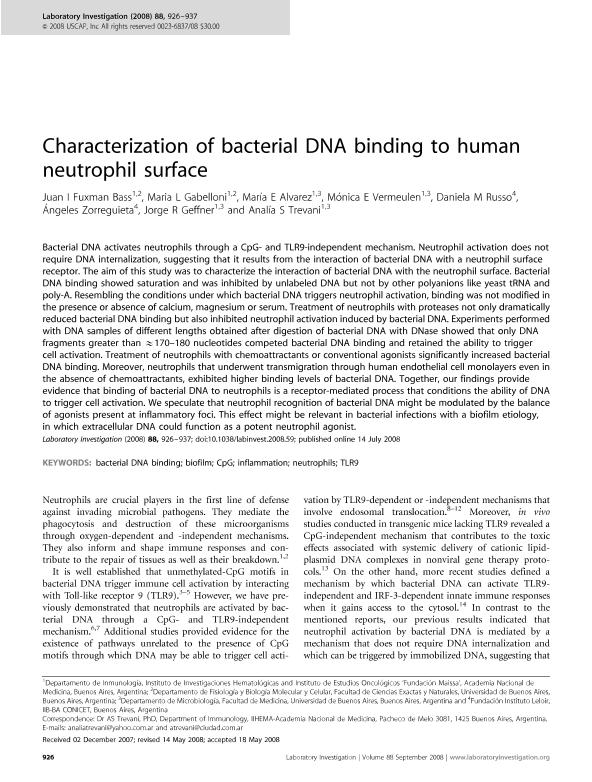Artículo
Characterization of bacterial DNA binding to human neutrophil surface
Fuxman Bass, Juan Ignacio ; Gabelloni, María Laura
; Gabelloni, María Laura ; Alvarez, Maria Eugenia
; Alvarez, Maria Eugenia ; Vermeulen, Elba Monica
; Vermeulen, Elba Monica ; Russo, Daniela Marta
; Russo, Daniela Marta ; Zorreguieta, Ángeles
; Zorreguieta, Ángeles ; Geffner, Jorge Raúl
; Geffner, Jorge Raúl ; Trevani, Analía Silvina
; Trevani, Analía Silvina
 ; Gabelloni, María Laura
; Gabelloni, María Laura ; Alvarez, Maria Eugenia
; Alvarez, Maria Eugenia ; Vermeulen, Elba Monica
; Vermeulen, Elba Monica ; Russo, Daniela Marta
; Russo, Daniela Marta ; Zorreguieta, Ángeles
; Zorreguieta, Ángeles ; Geffner, Jorge Raúl
; Geffner, Jorge Raúl ; Trevani, Analía Silvina
; Trevani, Analía Silvina
Fecha de publicación:
09/2008
Editorial:
Nature Publishing Group
Revista:
Laboratory Investigation
ISSN:
0023-6837
Idioma:
Inglés
Tipo de recurso:
Artículo publicado
Clasificación temática:
Resumen
Bacterial DNA activates neutrophils through a CpG- and TLR9-independent mechanism. Neutrophil activation does not require DNA internalization, suggesting that it results from the interaction of bacterial DNA with a neutrophil surface receptor. The aim of this study was to characterize the interaction of bacterial DNA with the neutrophil surface. Bacterial DNA binding showed saturation and was inhibited by unlabeled DNA but not by other polyanions like yeast tRNA and poly-A. Resembling the conditions under which bacterial DNA triggers neutrophil activation, binding was not modified in the presence or absence of calcium, magnesium or serum. Treatment of neutrophils with proteases not only dramatically reduced bacterial DNA binding but also inhibited neutrophil activation induced by bacterial DNA. Experiments performed with DNA samples of different lengths obtained after digestion of bacterial DNA with DNase showed that only DNA fragments greater than ≈170-180 nucleotides competed bacterial DNA binding and retained the ability to trigger cell activation. Treatment of neutrophils with chemoattractants or conventional agonists significantly increased bacterial DNA binding. Moreover, neutrophils that underwent transmigration through human endothelial cell monolayers even in the absence of chemoattractants, exhibited higher binding levels of bacterial DNA. Together, our findings provide evidence that binding of bacterial DNA to neutrophils is a receptor-mediated process that conditions the ability of DNA to trigger cell activation. We speculate that neutrophil recognition of bacterial DNA might be modulated by the balance of agonists present at inflammatory foci. This effect might be relevant in bacterial infections with a biofilm etiology, in which extracellular DNA could function as a potent neutrophil agonist. © 2008 USCAP, Inc All rights reserved.
Palabras clave:
BACTERIAL DNA BINDING
,
BIOFILM
,
CPG
,
INFLAMMATION
,
NEUTROPHILS
,
TLR9
Archivos asociados
Licencia
Identificadores
Colecciones
Articulos(IIBBA)
Articulos de INST.DE INVEST.BIOQUIMICAS DE BS.AS(I)
Articulos de INST.DE INVEST.BIOQUIMICAS DE BS.AS(I)
Articulos(IMEX)
Articulos de INST.DE MEDICINA EXPERIMENTAL
Articulos de INST.DE MEDICINA EXPERIMENTAL
Articulos(INIGEM)
Articulos de INSTITUTO DE INMUNOLOGIA, GENETICA Y METABOLISMO
Articulos de INSTITUTO DE INMUNOLOGIA, GENETICA Y METABOLISMO
Articulos(SEDE CENTRAL)
Articulos de SEDE CENTRAL
Articulos de SEDE CENTRAL
Citación
Fuxman Bass, Juan Ignacio; Gabelloni, María Laura; Alvarez, Maria Eugenia; Vermeulen, Elba Monica; Russo, Daniela Marta; et al.; Characterization of bacterial DNA binding to human neutrophil surface; Nature Publishing Group; Laboratory Investigation; 88; 9; 9-2008; 926-937
Compartir
Altmétricas



